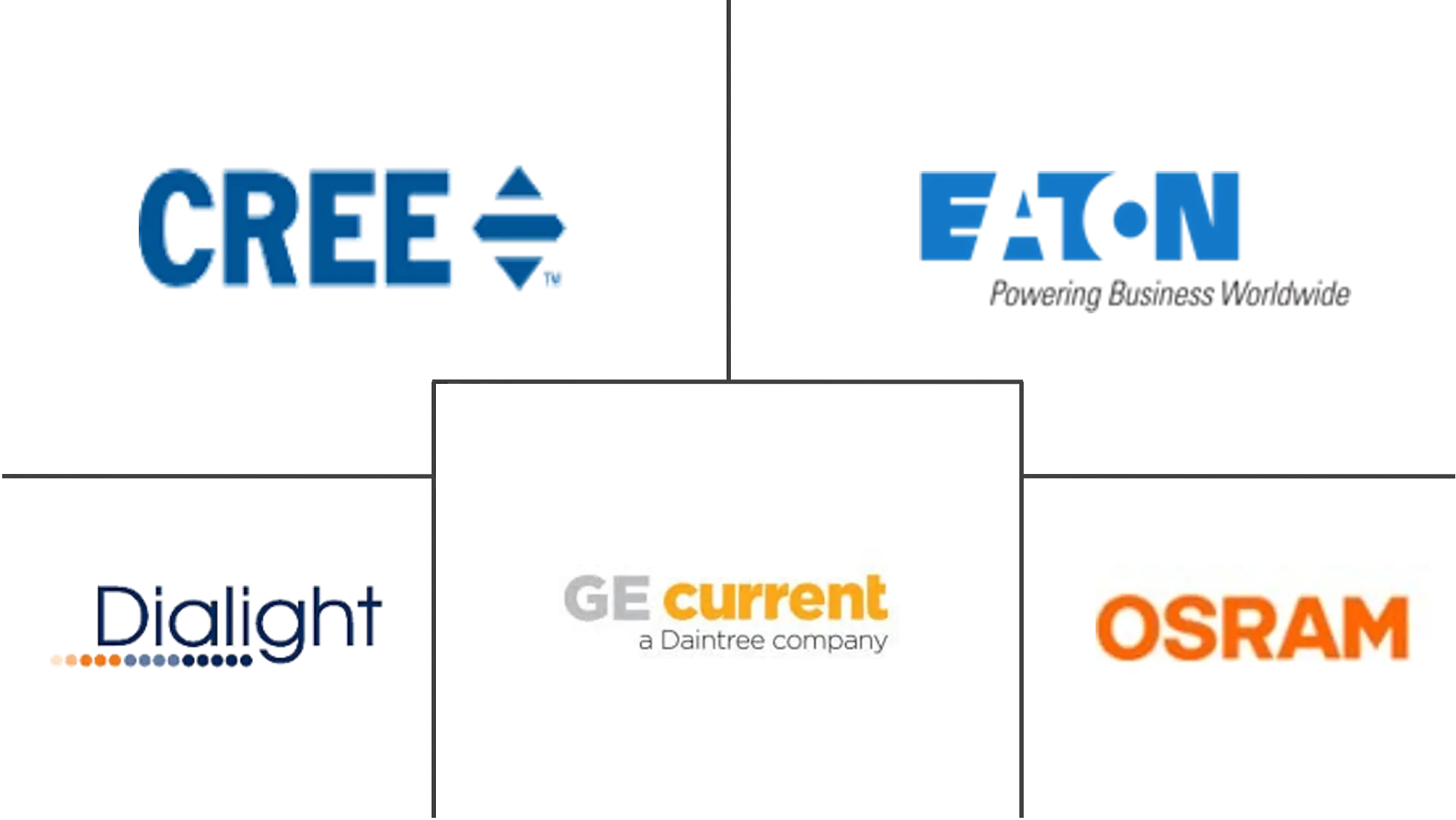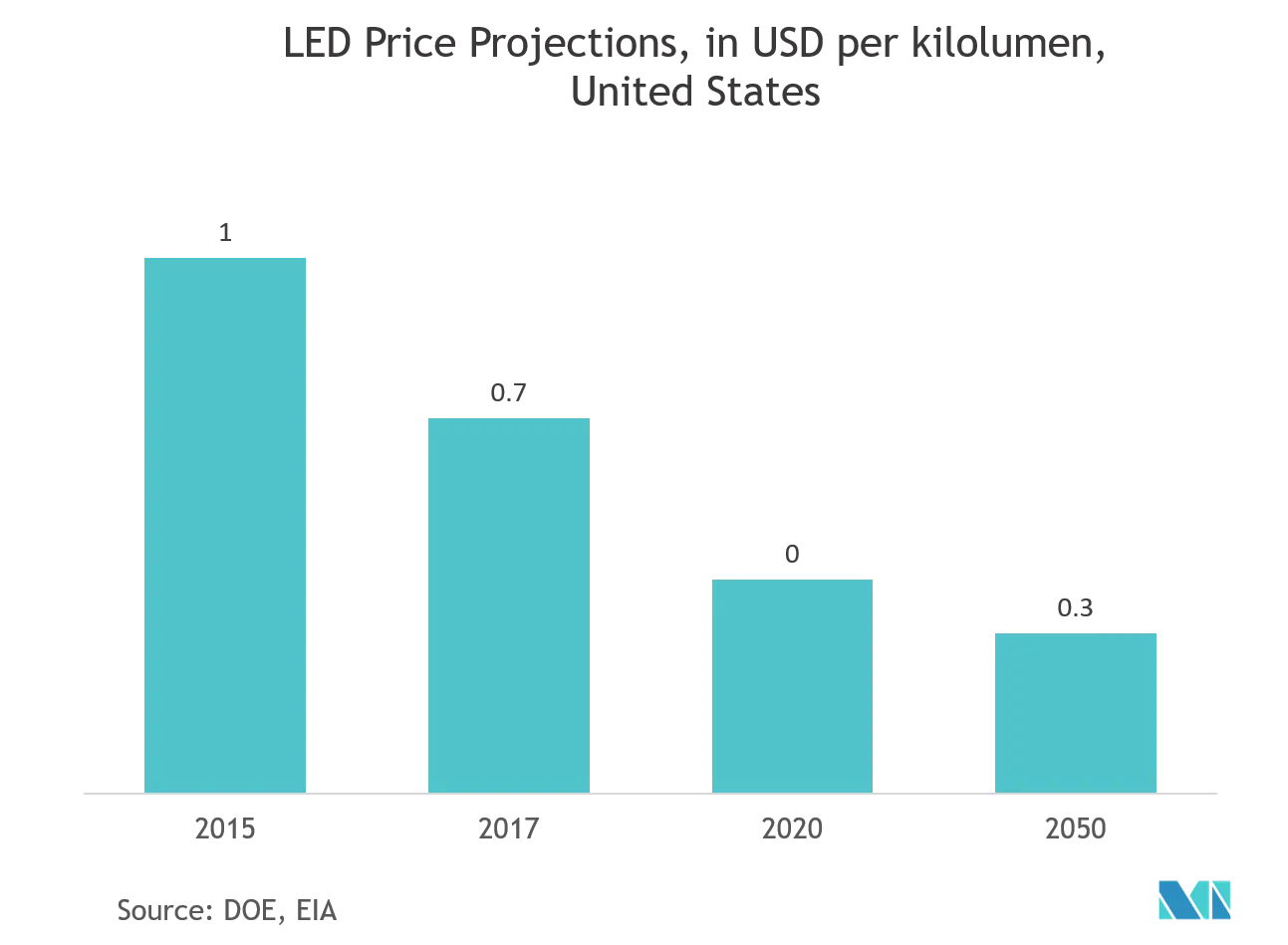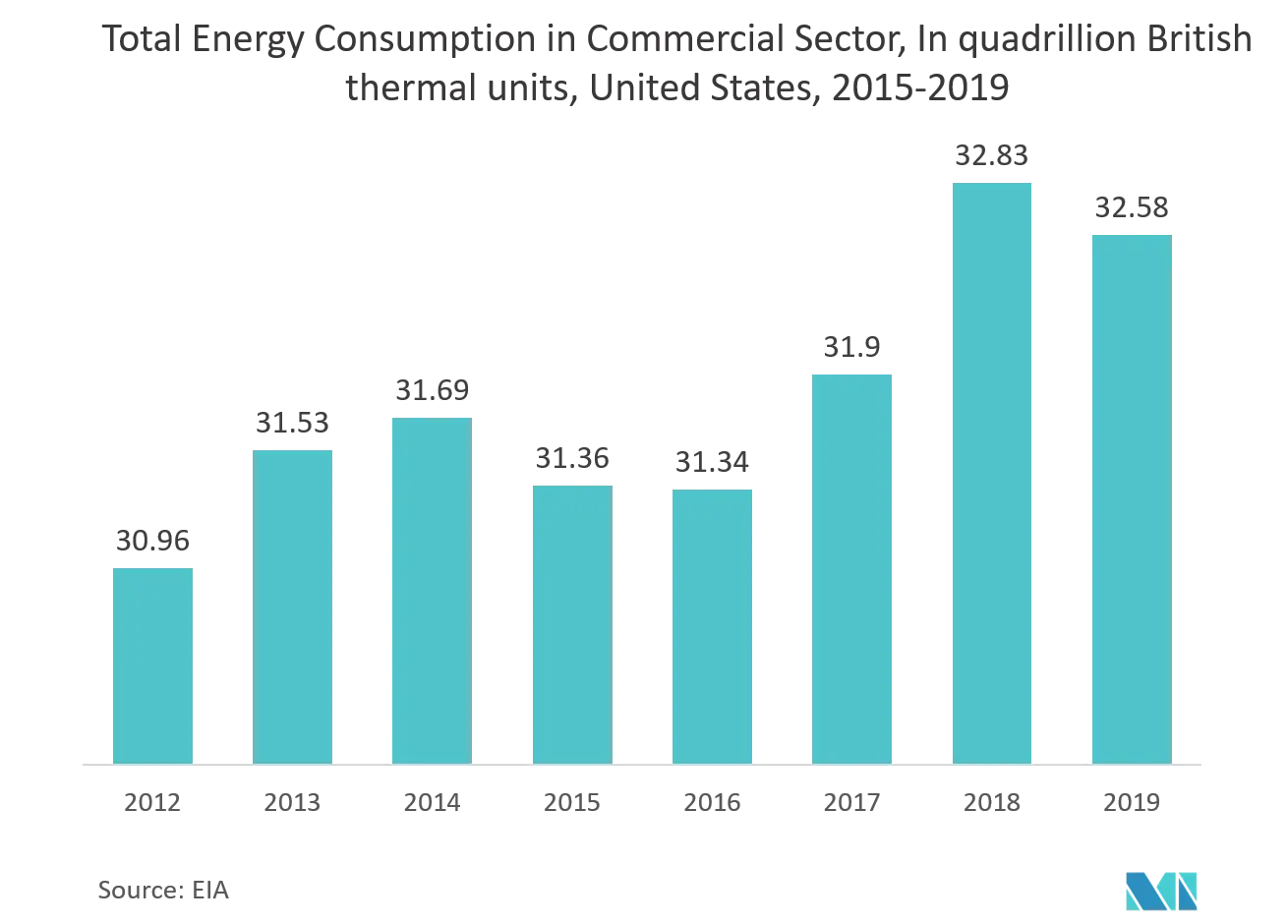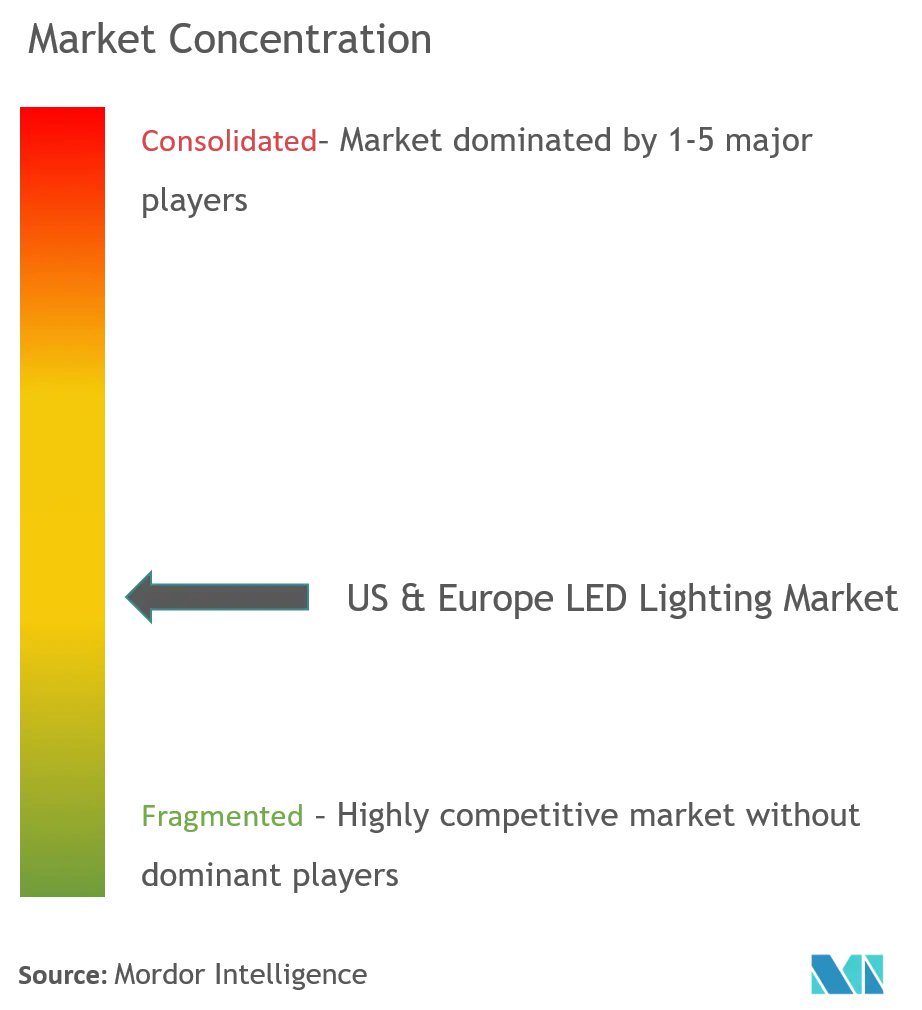US and Europe LED Lighting Market Size

| Study Period | 2019 - 2029 |
| Base Year For Estimation | 2023 |
| Forecast Data Period | 2024 - 2029 |
| Historical Data Period | 2019 - 2022 |
| CAGR | 9.40 % |
| Market Concentration | Low |
Major Players
*Disclaimer: Major Players sorted in no particular order |
US and Europe LED Lighting Market Analysis
The United States and Europe LED Lighting Market is expected to register a CAGR of approximately 9.4% during the forecast period (2020 - 2025). The demand for LED lighting solutions is growing rapidly, and with the advent of energy-efficient lighting solutions and smart Iot connectivity support, the adoption rate of LED is expected to increase further. According to the IEA, in 2019, the global LED sales reached over 10 billion units, including both light sources and luminaires, and LEDs are expected to make up over 90% of sales by 2030.
- The growing government regulations and push toward adopting energy-efficient solutions are the primary drivers behind the adoption of LED solutions. According to the United States Department of Energy, the widespread use of LED lighting offers a huge potential impact on energy savings in the United States, and by 2027, the use of LEDs can save about 348 TWh of electricity and a total savings of over USD 30 billion. Such developments are augmenting the demand.
- Owing to the growing demand, LED ecosystem players are expected to focus on increasing their production capacities and partner with other value chain players to fulfil their order demands. For instance, in March 2020, Epistar decided to increase its capital expenditure to expand capacity for Mini LED chip production, owing to the growing demand.
- Moreover, LED lighting solutions offer dimmable controls, and this feature is increasingly adopted in the residential sector and even in commercial buildings. As per the Lighting Controls Association, which is a part of the National Electrical Manufacturers Association (NEMA), prices are dropping for dimmable LEDs to levels comparable with standard on/off switches.
- Due to the COVID-19 pandemic outbreak, the market is witnessing halting of production and disruption in the supply chain, leading to weakened industrial output growth and the decline of light-manufacturing output across significant manufacturing hubs. The construction industry has also been affected, which has led to a slump in demand for lighting products. Owing to the restrictions put in place by the governments, construction activities and most of the business activities across multiple countries have been affected.
US and Europe LED Lighting Market Trends
This section covers the major market trends shaping the US & Europe LED Lighting Market according to our research experts:
Declining Prices of LED Products is Expected to Foster Growth
- Over the forecast period, the price of LED products is expected to fall to a point where significant savings from electricity consumption will deliver a short payback period, encouraging consumer adoption in mass. This lighting technology shift will significantly change the share of lamps sold for retrofit developments, where older lighting solution is often replaced precisely to improve efficiency.
- According to the Department of Energy and EIA, the price projection for LED in United States is expected to be USD 0.3 per kilolumen.
- According to the Building Technologies Office of the United States Department of Energy, if brand-name effects are ignored as significant price predictors, it has been observed that household LED lamps declined in price by more than 30% per year in the last five years. After controlling the brand-name effects, the price drops to a significant level. They have also found that a portion of the price drop has been driven by intense competition among several brands that have recently entered the market.
- After cumulative production doubles and redoubles rapidly in the recent years following introduction for new technology-enabled products, and significantly slow for mature products, relatively rapid price drops are generally predicted for new technologies such as energy-efficient LED lights.

United States Expected to Dominate the Market
- Governments across the United States are investing in smart and adaptive lights to improve energy efficiency. For instance, Chicago has launched a lighting program that aims to install 270,000 LED lights over the course of four years. During the first year of the project, the city installed 81,000 LED lights. Chicago estimates that it will save around USD 10 million each year in utility costs. The project includes a monitoring and control system that immediately alerts the city of any outages. It also allows workers to optimize the performance of the LED lights.
- Through significant partnerships with government authorities and players operating in the ecosystem, the market has been observing some opportunities in the recent years. For instance, in June 2020, the New York Power Authority (NYPA) entered into a partnership with Signify, one of the major players in lighting, to support Smart Street Lighting NY. It is a state-wide program that calls for at least half a million lights throughout the state to be replaced with energy-efficient LED technology by 2025.
- Several cities across the globe have already experienced savings from street & roadways lighting programs. For instance, New York City (United States) is replacing its 250,000 streetlights with high-efficiency LEDs. It estimates it will save USD 6 million in energy costs and USD 8 million in maintenance costs annually.
- Cities are increasingly investing in energy-efficient street lighting systems to replace or enhance their outdated systems. While reliable and bright public lighting reduces accidents and crime and allows for economic activity after sunset, modern energy-efficient street-lighting technology can also lower energy consumption as well as operation and maintenance costs significantly.
- Furthermore, various government initiatives are leading to a higher adoption of LED lighting, which is catering to the market growth of lighting as a service. During 2019, the Trump administration announced it plans to use much more energy-efficient light bulbs to reduce the energy consumption rate and to help in controlling carbon emission, that primarily gets generated in the United States from natural gas-powered plants for electricity generation. As per the plan, all light bulbs sold in the United States must be either LED or fluorescent to meet energy standards.

US and Europe LED Lighting Industry Overview
The competitive landscape of the United States and Europe LED Lighting Market is moderately fragmented due to the presence of several global and regional players. The market players are increasingly innovating LED Lighting technologies for various end-user industries across these regions, leading to growth and expansion of their market presence and foothold.
- January 2020 - Signify, the new company name of the Philips Lighting division launched its latest GreenPower LED top lighting compact production module. The module is specially designed for a vertical growth system and can be used as either a new solution or in existing installations. According to the company, the new GreenPower LED module is optimized for closed, climate-controlled cultivation facilities, such as the city/vertical farms, propagation and research centers that primarily use multilayer growth systems to grow crops including lettuce and other leafy greens, soft fruits, herbs, and young plants.
- October 2019 - Dalkia, one of the leaders in building energy services and a subsidiary of the EDF Group, launched its brand in the United States to strengthen its presence with commercial, industrial and institutional customers. With Dalkia Energy Solutions (new name of Groom Energy Solutions) and Aegis Energy Services, Dalkia combines the Group's expertise in energy efficiency and local energy production.
US and Europe LED Lighting Market Leaders
-
Cree Inc.
-
Dialight PLC
-
Eaton Corporation PLC
-
Current Lightning Solutions LLC
-
OSRAM GmbH
*Disclaimer: Major Players sorted in no particular order

US and Europe LED Lighting Market Report - Table of Contents
1. INTRODUCTION
- 1.1 Study Assumptions & Market Definition
- 1.2 Scope of the Study
2. RESEARCH METHODOLOGY
3. EXECUTIVE SUMMARY
4. MARKET DYNAMICS
- 4.1 Market Overview
-
4.2 Market Drivers
- 4.2.1 Increase in Need for Energy-efficient Lighting Systems and Favorable Government Regulations
- 4.2.2 Declining Prices of LED Products
-
4.3 Market Restraints
- 4.3.1 High Initial Investment
- 4.3.2 Development of Alternative Technologies
- 4.4 Industry Value Chain Analysis
-
4.5 Industry Attractiveness - Porter's Five Forces Analysis
- 4.5.1 Threat of New Entrants
- 4.5.2 Bargaining Power of Buyers/Consumers
- 4.5.3 Bargaining Power of Suppliers
- 4.5.4 Threat of Substitute Products
- 4.5.5 Intensity of Competitive Rivalry
- 4.6 Technology Snapshot
- 4.7 Assessment of Impact of Covid-19 on the Market
5. MARKET SEGMENTATION
-
5.1 Application
- 5.1.1 Commercial Offices
- 5.1.2 Retail
- 5.1.3 Hospitality
- 5.1.4 Industrial
- 5.1.4.1 Warehouses and Factories
- 5.1.4.2 Hazardous Zones
- 5.1.4.3 Other Industrial Applications
- 5.1.5 Other Applications
-
5.2 Product Type
- 5.2.1 Lamps
- 5.2.2 Luminaries
-
5.3 Distribution Channel
- 5.3.1 Direct Sales
- 5.3.2 Wholesale Retail
-
5.4 Geography
- 5.4.1 North America
- 5.4.1.1 United States
- 5.4.1.2 Canada
- 5.4.2 Europe
- 5.4.2.1 United Kingdom
- 5.4.2.2 Germany
- 5.4.2.3 France
- 5.4.2.4 Rest of Europe
6. COMPETITIVE LANDSCAPE
-
6.1 Company Profiles
- 6.1.1 Cree Inc.
- 6.1.2 Dialight PLC
- 6.1.3 Eaton Corporation
- 6.1.4 General Electric Company
- 6.1.5 OSRAM GmbH
- 6.1.6 Nichia Corporation
- 6.1.7 Sharp Corporation
- 6.1.8 Signify Holding (Philips Lighting)
- 6.1.9 Virtual Extension
- 6.1.10 Zumtobel Group AG
- 6.1.11 Panasonic Corporation
- 6.1.12 Hubbel Incorporated
- 6.1.13 US LED Limited
- *List Not Exhaustive
7. INVESTMENT ANALYSIS
8. MARKET OPPORTUNITIES AND FUTURE TRENDS
** Subject To AvailablityUS and Europe LED Lighting Industry Segmentation
LED stands for light-emitting diode. LED lighting products produce light approximately 90% more efficiently than incandescent light bulbs, such as fluorescent and incandescent lights. About 95% of the energy in LEDs is converted into light and only 5% is wasted as heat, which is leading consumers to opt for a more efficient form of lighting.
As per the scope of the study, the market has been segmented based on product type, application, distribution channel, and geography.
In the regional level, the market numbers were collated by calculating the penetration scenarios in the major geographies.
The market study also focused on the impact of the COVID-19 pandemic on the market ecosystem.
| Application | Commercial Offices | |
| Retail | ||
| Hospitality | ||
| Industrial | Warehouses and Factories | |
| Hazardous Zones | ||
| Other Industrial Applications | ||
| Other Applications | ||
| Product Type | Lamps | |
| Luminaries | ||
| Distribution Channel | Direct Sales | |
| Wholesale Retail | ||
| Geography | North America | United States |
| Canada | ||
| Geography | Europe | United Kingdom |
| Germany | ||
| France | ||
| Rest of Europe |
US and Europe LED Lighting Market Research FAQs
What is the current US & Europe LED Lighting Market size?
The US & Europe LED Lighting Market is projected to register a CAGR of 9.40% during the forecast period (2024-2029)
Who are the key players in US & Europe LED Lighting Market?
Cree Inc., Dialight PLC, Eaton Corporation PLC, Current Lightning Solutions LLC and OSRAM GmbH are the major companies operating in the US & Europe LED Lighting Market.
What years does this US & Europe LED Lighting Market cover?
The report covers the US & Europe LED Lighting Market historical market size for years: 2019, 2020, 2021, 2022 and 2023. The report also forecasts the US & Europe LED Lighting Market size for years: 2024, 2025, 2026, 2027, 2028 and 2029.
US and Europe LED Lighting Industry Report
Statistics for the 2024 US and Europe LED Lighting market share, size and revenue growth rate, created by Mordor Intelligence™ Industry Reports. US and Europe LED Lighting analysis includes a market forecast outlook 2029 and historical overview. Get a sample of this industry analysis as a free report PDF download.



